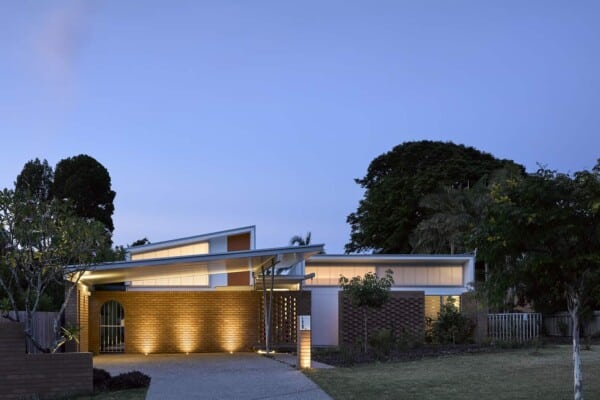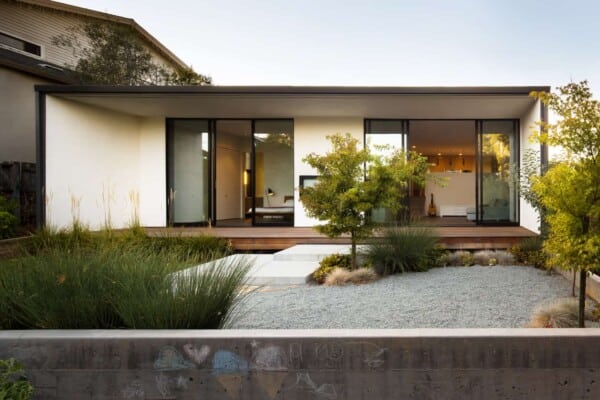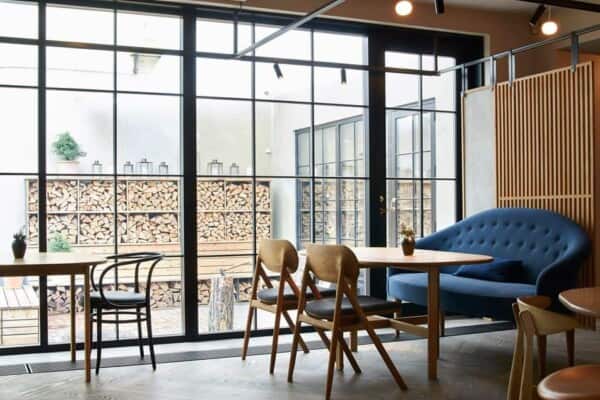El Caserón is a modern residence situated in Zaragoza, Spain that was designed by G///bang in 2008.
It is a single story home with an interior garden that has been placed between the sleeping quarters to provide warmth and light.
El Caserón by G///bang:
“The family. – A couple and a seven year old boy plus a dog. Old but with a great retirement. They christened the house “El Caserón”.
They lived renting and they decided to pawn their savings in buying a lot that included an insultingly tasteless house, in my opinion. I decided not to demolish the house, with the family’s permission.
We tried to avoid mediocrity looking for the best in the worst.
How did they want their house?
We imagined its layout in a single floor.
The transition between the interior and the exterior should be smooth, absent of material limits.
We were attracted to enhance interpersonal relationships through contact and visual control from anywhere in the house.
The project.- It is the remodeling and expansion of an existing single-family house, located in a lot of 1000 square meters, in a residential district of isolated, single-family homes.
The existing building was comprised of two parts. On one hand, a main body in the front area of the lot, 10×12 meters, with load bearing walls and Arabic tile roof (preserved), and on the other hand, a small attached volume, 3×6 meters, with a flat room (demolished).
The pre-existing volume was restored, connected to a new horizontal structure that would complete the program. The interior clearances were varied between rooms to obtain new visuals and an intense interior/exterior connection.
Layout / circulation.- The preserved, main volume contains the daytime area: sink, living room, dining room, kitchen, guest bedroom, bathroom, game room and laundry; the new structure contains the access hall, garage, gym, covered pool, children’s bedroom and a small apartment for the couple.
The circulation is L-shaped along the interior perimeter, but in the main volume, it is transformed into a multi-directional, flexible space that takes advantage of the mobility of the wood partition walls.
The sliding exterior woodwork, large and embedded into the walls, cover the entire facade allowing a visual and formal connection between the dwelling and the courtyards and other landscaped spaces, eliminating the materiality from the interior-exterior transition.
Formal / spatial / figurative quality.- It was a surprise to discover a revealing concept: “the figurative quality” that depended on the technological condition with which the shape was constructed, and it was, at the same time, a generator of form in the terrain at the subsequent scale.
In the same way that form and space were not cause and effect, but reciprocal consequences, the architectonic figuration preceded the expression of the form and was simultaneously generated with its modeling, and even in the spatial program.
Geometry.- The resulting building does not correspond with a recognizable geometry, but instead adapts to the available space in the lot, following criteria of subtraction of matter instead of addition.
Material / color.- The preserved volumes are clad in white lime mortar with trowel, and the new concrete buildings are white. In the coatings that complete the woodwork planes, coping and guttering, untreated marine aluminum was used. The white color reinforces the reciprocal space/form result.
Energy system.- Energy efficiency mechanisms have been added, such as the use of geothermal energy to power the air conditioning in winter and summer, associated with the floor heating system.
Urubó Hills is a picturesque landscape with native vegetation together with a wide and eclectic catalog of architecture. Such is the landscape that gives context to the Calderón House.
Under a simple reading the project involves two horizontal volumes: the lowest one visually set back and anchored in the landscape; and the top one, set as if it were floating in the air.
Material textures are essential components in the project. Stone and wood finishes are elements that beyond giving a reading between volumes, they provide this contemporary home with the sensibility of a traditional architecture environment.
The ground floor houses the public and common spaces: living and dining room, kitchen, study, bathrooms and a gallery that makes for an outdoor seating space that connects its sights with a green garden holding a swimming pool that connects the house with the barbecue place.
It is in this area that the service facilities are resolved without being perceived, consisting of a laundry area, a bedroom with bathroom and one bathroom for the pool area.
A floating staircase with wooden steps, located on the distribution hall of the ground floor, leads to a small family living room where natural light becomes the benchmark of vitality for the house.
An interior garden bathes the wall with nuances of light and shadow providing added warmth to this space that serves as a link between the rooms of children and adults.”


Photos by: Jesús Granada































































